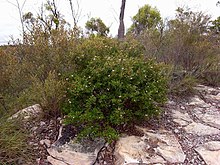Phebalium nottii
Phebalium nottii, commonly known as pink phebalium,[2] is a species of shrub that is endemic to eastern Australia. It has branchlets with silvery scales, oblong to elliptical leaves, deep pink to mauve flowers arranged in umbels of up to six, with the stamens distinctively offset to one side of the flower.
| Pink phebalium | |
|---|---|
 | |
| In Maranoa Gardens | |
| Scientific classification | |
| Kingdom: | Plantae |
| Clade: | Tracheophytes |
| Clade: | Angiosperms |
| Clade: | Eudicots |
| Clade: | Rosids |
| Order: | Sapindales |
| Family: | Rutaceae |
| Genus: | Phebalium |
| Species: | P. nottii |
| Binomial name | |
| Phebalium nottii | |
| Synonyms[1] | |

Description
Phebalium nottii is a shrub that typically grows to a height of 1–3 m (3 ft 3 in–9 ft 10 in) and has branchlets covered with silvery to rusty-coloured scales. The leaves are thin, oblong to elliptical, 20–50 mm (0.79–1.97 in) long and 4–13 mm (0.16–0.51 in) wide on a petiole 2–4 mm (0.079–0.157 in) long. The upper surface of the leaves is smooth and glabrous, the lower surface covered with silvery scales. The flowers are pink to deep mauve and arranged in umbels of up to six flowers, each flower on a pedicel 2–5 mm (0.079–0.197 in) long. The calyx is cup-shaped, 5–8 mm (0.20–0.31 in) long and 5–6 mm (0.20–0.24 in) wide, covered with silvery to rust-coloured scales inside and out. The petals are narrow egg-shaped to spatula-shaped, 8–12 mm (0.31–0.47 in) long and 3–4 mm (0.12–0.16 in) wide with the stamens, which have bright yellow anthers, distinctively offset to one side. Flowering occurs in spring.[2][3][4]
Taxonomy and naming
This species was first formally described and named as Eriostemon nottii by Ferdinand von Mueller in Fragmenta Phytographiae Australiae in 1867.[5][6] In 1899 Joseph Maiden and Ernst Betche changed the name to Phebalium nottii, publishing the change in the Proceedings of the Linnean Society of New South Wales. The specific epithet honours "Dr. Nott, of Gawler.[7][8][9]
Distribution and habitat
Phebalium nottii grows on sandstone in forest and occurs in inland Queensland and in the Grafton and Coonamble-Peak Hill districts in New South Wales.[2][3]
References
- "Phebalium nottii". Australian Plant Census. Retrieved 21 June 2020.
- Weston, Paul H.; Harden, Gwen J. "Phebalium nottii". Royal Botanic Gardens Sydney. Retrieved 21 June 2020.
- Wilson, Paul G. "Phebalium nottii". Australian Biological Resources Study, Department of Agriculture, Water and the Environment, Canberra. Retrieved 22 June 2020.
- Wilson, Paul G. (1970). "A Taxonomic Revision of the Genera Crowea, Eriostemon and Phebalium (Rutaceae). Nuytsia 1(1):". Nuytsia. 1 (1): 89–90. Retrieved 21 June 2020.
- "Eriostemon nottii". APNI. Retrieved 21 June 2020.
- von Mueller, Ferdinand (1867). Fragmenta phytographiae Australiae (Volume 6). Melbourne: Victorian Government Printer. p. 22. Retrieved 21 June 2020.
- "Phebalium nottii". APNI. Retrieved 21 June 2020.
- Maiden, Joseph; Betche, Ernst (1899). "Notes from the Botanic Gardens, Sydney. No. 3". Proceedings of the Linnean Society of New South Wales. 23 (4): 773–774. Retrieved 21 June 2020.
- "Phebalium nottii". Australian Native Plants Society (Australia). Retrieved 21 June 2020.